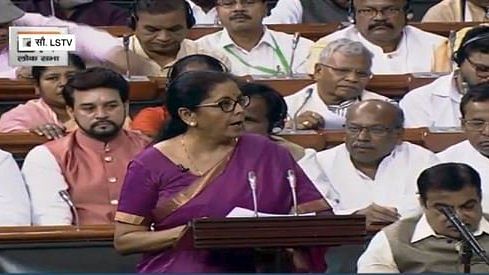Mumbai: India’s new finance minister resisted calls for a fiscal boost to spur a weakening economy, sticking instead to a plan to narrow the budget deficit over time by keeping spending in check.
The fiscal gap target for the year that began on April 1 was lowered to 3.3% of gross domestic product from 3.4% set in February’s interim plan, Nirmala Sitharaman said in her maiden budget in Parliament in New Delhi on Friday. The deficit is forecast to come down even further to 3% of GDP by March 2021, according to the Finance Ministry.
Sitharaman, 59, will be relying on an ambitious revenue target to narrow the deficit as the government reins in spending: she plans to increase taxes on the wealthy, raise duties on gold and gasoline, extract higher dividends from the central bank and boost income from asset sales. On the expenditure side, $11 billion was set aside for farmer support and nearly as much for a capital boost to banks.
Her budget drew applause from bond and currency investors, but left credit rating companies with mixed feelings and stock traders with losses. Yields on India’s benchmark 10-year bonds dropped 8 basis points to 6.67%, while the benchmark equity index closed 1% lower, the first drop in five days.
The absence of any substantial fiscal stimulus puts the ball back in the central bank’s court to spur growth. The Reserve Bank of India has already cut interest rates three times this year and signaled more easing to come as the global economy continues to weaken.
Also read: Budget 2019 shows how India can not only become $5 trillion economy, but can also do it fast
Achieving the competing goals of a lower fiscal deficit and faster growth will be “very challenging,” said Gene Fang, associate managing director at Moody’s Investor Services in Singapore. “We expect the economy to grow relatively slowly.”
Under Pressure
What Bloomberg Economists Say
“The first budget of Prime Minister Narendra Modi’s 2.0 government renewed its commitment to fiscal discipline, which bodes well for lower interest rates. The budget’s rigor should help support a V-shaped economic recovery.”– Abhishek Gupta, India economist
Sitharaman, who is known to be fiscally conservative, focused her budget on plans to unclog infrastructure bottlenecks and revive investments.
She promised to recapitalize weak state-run banks by 700 billion rupees and announced a package for the stricken shadow-banking sector. The debt-related woes among non-banking finance companies have been one of the prime reasons for a slowdown in consumption, which contributes nearly 60% to the nation’s GDP.
Sitharaman proposed steps to deepen infrastructure financing in the country and measures to boost foreign participation in the corporate debt market. She said the nation needs 20 trillion rupees annual investment on infrastructure, and the government will be tapping the overseas bond market for funds for the first time ever.
“The budget, by itself, is unlikely to spur growth significantly,” said Priyanka Kishore, head of India and Southeast Asia economics at Oxford Economics in Singapore. “But continued focus on infrastructure spending and measures like recapitalization of banks and a package of the shadow banking sector should create a positive environment for reviving private investment.”
Also read: Arun Jaitley writes Budget 2019 blends good economics & politics, like in Modi’s first term
The Finance Ministry on Wednesday said growth will probably reach 7% in the current fiscal year, pinning its hopes on greater political stability to spur investments. That forecast matches the RBI’s projection and is higher than last year’s expansion of 6.8%.
For now, though, the attention will shift to the central bank to provide support to the economy.
“The government’s commitment to fiscal consolidation gives the RBI more leeway to ease in the coming months,” Kishore said. -Bloomberg







Rate cuts are a red herring. Finance Secretary said recently that the government as a whole – including the states – is absorbing 85 – 90 % of household savings, leaving not enough for the private sector to access at affordable rates of interest. This he said had prevented transmission of the 75 basis points cuts already announced by the RBI. For the government to maintain fiscal rectitude would do more for the economy than fiscal stimulus. 2. Some tax proposals merit reconsideration. 5% import duty on books, 10% on newsprint. An unacceptable tax on knowledge, vidhya, Saraswati.